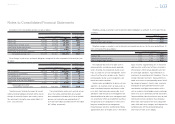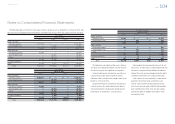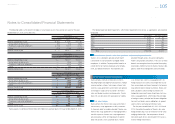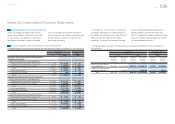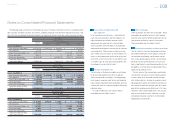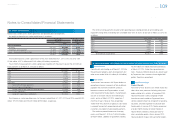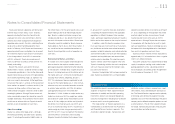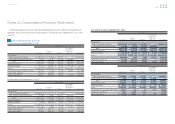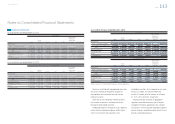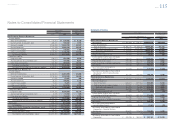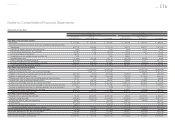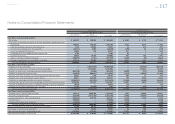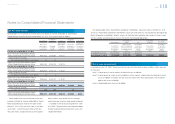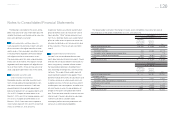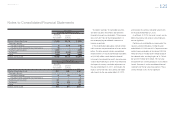Toyota 2013 Annual Report Download - page 111
Download and view the complete annual report
Please find page 111 of the 2013 Toyota annual report below. You can navigate through the pages in the report by either clicking on the pages listed below, or by using the keyword search tool below to find specific information within the annual report.
Toyota Global Vision President’s Message Launching a New Structure Special Feature Review of Operations
Consolidated Performance
Highlights
Management and
Corporate Information Investor InformationFinancial Section
Page 111
NextPrev
ContentsSearchPrint
ANNUAL REPORT 2013
Toyota also received subpoenas and formal and
informal requests from various states’ attorneys
general, including the Executive Committee for
a group of 30 states’ plus one territory’s attorney
general, and certain local governmental agencies
regarding various recalls, the facts underlying those
recalls and customer handling related to those
recalls. In February 2013, Toyota and the attorneys
general resolved these investigations for an amount
not material to Toyota. Such amount was included
in the charge taken in fi scal 2013. In connection
with this settlement, Toyota also made commit-
ments to continue to conduct certain activities it is
already undertaking.
Beyond the amounts accrued for the recall-
related matters, Toyota is unable to estimate a range
of reasonably possible loss, if any, for the other recall-
related matters because (i) many of the proceedings
are in evidence gathering stages, (ii) signifi cant fac-
tual issues need to be resolved, (iii) the legal theory
or nature of the claims is unclear, (iv) the outcome of
future motions or appeals is unknown and/or (v) the
outcomes of other matters of these types vary
widely and do not appear suffi ciently similar to offer
meaningful guidance. Although Toyota cannot esti-
mate a reasonable range of loss based on currently
available information, the resolution of these matters
could have an adverse effect on Toyota’s fi nancial
position, results of operations or cash fl ows.
Other Proceedings
Toyota has various other legal actions, other gov-
ernmental proceedings and other claims pending
against it, including other product liability claims in
in January 2007. Currently, there are uncertainties
surrounding the implementation of the applicable
regulations in different European Union member
states, particularly regarding manufacturer responsi-
bilities and resultant expenses that may be incurred.
In addition, under this directive member states
must take measures to ensure that car manufactur-
ers, distributors and other auto-related economic
operators establish adequate used vehicle collection
and treatment facilities and to ensure that hazardous
materials and recyclable parts are removed from
vehicles prior to shredding. This directive impacts
Toyota’s vehicles sold in the European Union and
Toyota is introducing vehicles that are in compliance
with such measures taken by the member states
pursuant to the directive.
Based on the legislation that has been enacted to
date, Toyota has provided for its estimated liability
the United States. For the same reasons discussed
above relating to the recall-related legal proceed-
ings, Toyota is unable to estimate a range of rea-
sonably possible loss, if any, beyond the amounts
accrued, with respect to these claims. Based upon
information currently available to Toyota, however,
Toyota believes that its losses from these matters, if
any, would not have a material adverse effect on
Toyota’s fi nancial position, results of operations or
cash fl ows.
Environmental Matters and Others
In October 2000, the European Union brought into
effect a directive that requires member states to
promulgate regulations implementing the following:
(i) manufacturers shall bear all or a signifi cant part of
the costs for taking back end-of-life vehicles put on
the market after July 1, 2002 and dismantling and
recycling those vehicles. Beginning January 1,
2007, this requirement became applicable to vehi-
cles put on the market before July 1, 2002; (ii) man-
ufacturers may not use certain hazardous materials
in vehicles to be sold after July 2003; (iii) vehicles
type-approved and put on the market after
December 15, 2008, shall be re-usable and/or recy-
clable to a minimum of 85% by weight per vehicle
and shall be re-usable and/or recoverable to a mini-
mum of 95% by weight per vehicle; and (iv) end-of-
life vehicles must meet actual re-use of 80% and
re-use as material or energy of 85%, respectively, of
vehicle weight by 2006, rising respectively to 85%
and 95% by 2015. A law to implement the directive
came into effect in all member states including
Bulgaria, Romania that joined the European Union
related to covered vehicles in existence as of March
31, 2013. Depending on the legislation that will be
enacted subject to other circumstances, Toyota
may be required to revise the accruals for the
expected costs. Although Toyota does not expect
its compliance with the directive to result in signifi -
cant cash expenditures, Toyota is continuing to assess
the impact of this future legislation on its fi nancial posi-
tion, results of operations and cash fl ows.
Toyota purchases materials that are equivalent to
approximately 10% of material costs from a supplier
which is an affi liated company.
The parent company has a concentration of labor
supply in employees working under collective bar-
gaining agreements and a substantial portion of
these employees are working under the agreement
that will expire on December 31, 2014.
The operating segments reported below are the
segments of Toyota for which separate fi nancial
information is available and for which operating
income/loss amounts are evaluated regularly by
executive management in deciding how to allocate
resources and in assessing performance.
The major portions of Toyota’s operations on a
worldwide basis are derived from the Automotive
and Financial Services business segments. The
Automotive segment designs, manufactures and
distributes sedans, minivans, compact cars, sport-
utility vehicles, trucks and related parts and accesso-
ries. The Financial Services segment consists primarily
of fi nancing, and vehicle and equipment leasing
operations to assist in the merchandising of the parent
company and its affi liated companies products as well
as other products. The All Other segment includes
the design, manufacturing and sales of housing, tele-
communications and other business.
24. Segment data
Notes to Consolidated Financial Statements
Selected Financial Summary (U.S. GAAP) Consolidated Segment Information Consolidated Quarterly Financial Summary Management’s Discussion and Analysis of Financial Condition and Results of Operations Consolidated Financial Statements Notes to Consolidated Financial Statements [34 of 44]
Management’s Annual Report on Internal Control over Financial Reporting Report of Independent Registered Public Accounting Firm




